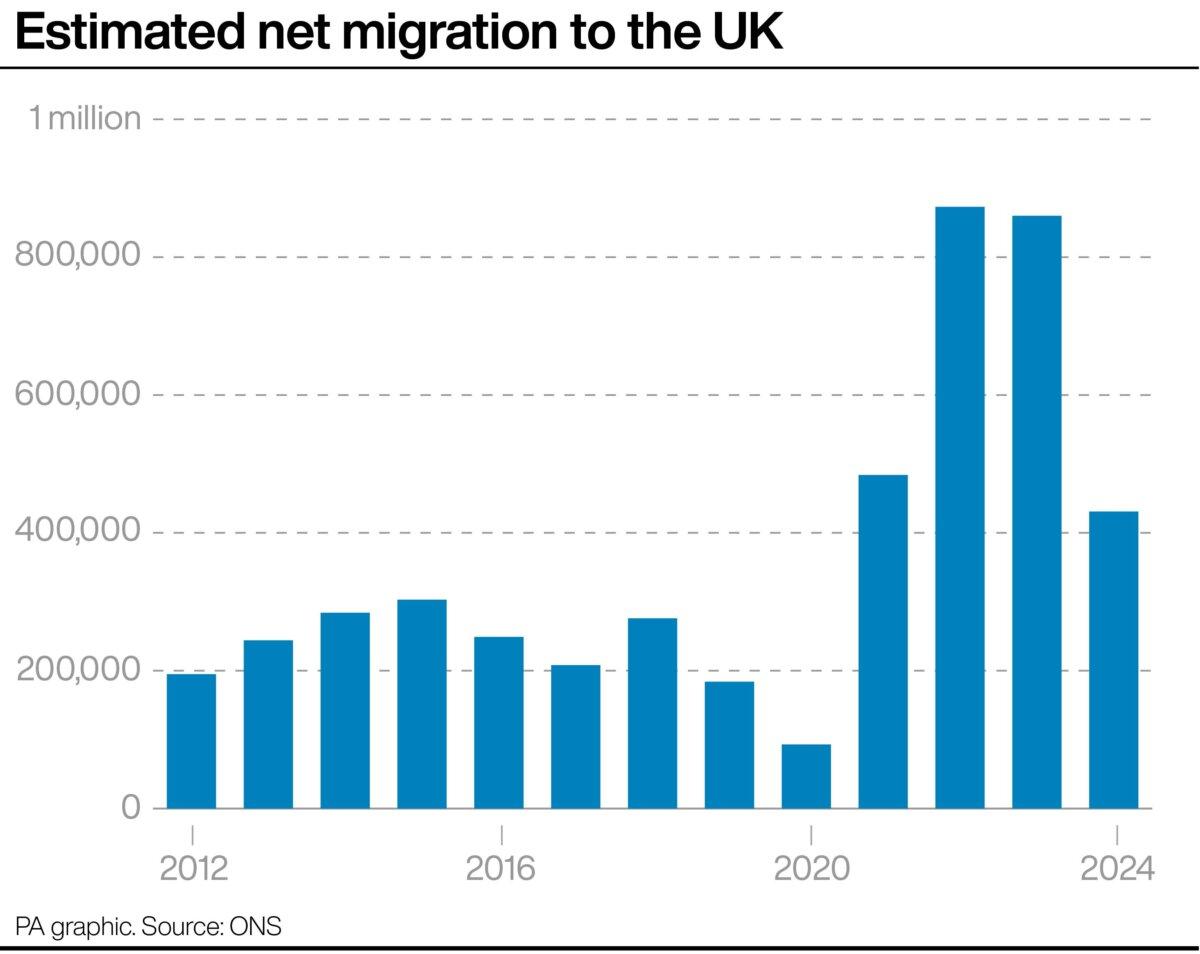Net migration nearly halved in the course of one year, but still remains far higher than in the previous years before the COVID-19 pandemic, according to figures from the Office for National Statistics (ONS).
In the year to December 2024, the difference between the number of people moving to the UK and leaving was an estimated 431,000, down 49.9 percent from 860,000 the year before, the largest numerical drop in any 12-month period.
The ONS’s director of population statistics, Mary Gregory, said on Thursday that the decline was largely driven by a falling number of immigrants coming to the UK to work and study, “particularly student dependants.”
Long-Term Immigration Falls
The ONS said that the largest drop in immigration was from non-EU nationals coming here to work, falling 108,000, or 49 percent. Immigration for study purposes declined by 17 percent.Long-term immigration also fell to 948,000, down 28.5 percent from 1,326,000 in the previous year, the first time in three years the figure was below 1 million.
Emigration also rose by around 11 percent to an estimated 517,000, up from 466,000 on the previous year. Gregory said that was especially owing to “people leaving who originally came on study visas once pandemic travel restrictions to the UK were eased.”
The impact of Conservative policy on dependant visas saw an 86 percent (105,000) reduction in study dependants, and a 35 percent (81,000) decrease in the number of work dependants.
Home Secretary Yvette Cooper said that the fall in net migration is “welcome after the figures quadrupled to nearly a million in the last parliament.”
“Our Immigration White Paper sets out radical reforms to further reduce net migration,” she added.
Higher Than Pre-Pandemic Levels
While these figures are a dramatic decline on 2022 and 2023, they are still far higher than the pre-pandemic era, and well above the pre-Brexit peak of roughly 300,000.Net migration was broadly flat in the years leading up to the lockdown, standing at 208,000 in 2017, 276,000 in 2018, and 184,000 in 2019.
They then fell sharply in 2020 to 93,000, when travel restrictions were put in place.
Net migration then rose to 484,000 in 2021, 873,000 in 2022, and dropped slightly to 860,000 in 2023.

The Migration Observatory at the University of Oxford noted that this “recording-breaking decline” was possible “primarily because numbers had previously been so high.”
“The declines reflect a period of policy liberalisation post-Brexit which saw net migration reach a record 906,000 in the year to June 2023, followed by restrictions in early 2024, both under the previous government,” the Migration Observatory said.
Migration Observatory researcher Ben Brindle said that net migration figures will continue to fall, as the previous government’s restrictions “are not yet fully visible in the data.”
‘Relatively Small’ Economic Impact
The Labour government has maintained the previous administration’s visa rules, with Prime Minister Sir Keir Starmer announcing further measures to bring down legal immigration in the White Paper published last week.These include ending the recruitment of overseas care workers, raising the skills requirements for visas to degree level, and charging universities a levy on international students.
Migration Observatory Director Madeleine Sumption said the economic impact of this fall in migrant workers is “actually likely to be relatively small.”
She added, “That’s because the groups that have driven the decline, such as study and work dependants, are neither the highest skilled, highest-paid migrants who make substantial contributions to tax revenues, nor the most disadvantaged groups that require substantial support.”
Similarly, Downing Street indicated that it was not concerned that a fall in migrant workers would lead to a workforce shortage.
The prime minister’s official spokesman said, “We are, for the first time, setting out a strategy to properly bring together a domestic skills strategy together with an immigration strategy.”
“So we will be reducing our reliance on overseas labour by training up our domestic workforce and ensuring, as the public rightly expects, that our border system is secure,” he added.







